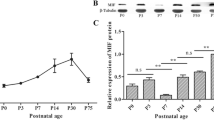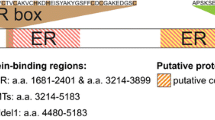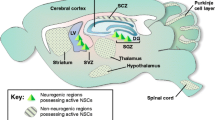Abstract
PML is a tumor suppressor protein involved in the pathogenesis of promyelocytic leukemia. In non-neuronal cells, PML is a principal component of characteristic nuclear bodies. In the brain, PML has been implicated in the control of embryonic neurogenesis, and in certain physiological and pathological phenomena in the adult brain. Yet, the cellular and subcellular localization of the PML protein in the brain, including its presence in the nuclear bodies, has not been investigated comprehensively. Because the formation of PML bodies appears to be a key aspect in the function of the PML protein, we investigated the presence of these structures and their anatomical distribution, throughout the adult mouse brain. We found that PML is broadly expressed across the gray matter, with the highest levels in the cerebral and cerebellar cortices. In the cerebral cortex PML is present exclusively in neurons, in which it forms well-defined nuclear inclusions containing SUMO-1, SUMO 2/3, but not Daxx. At the ultrastructural level, the appearance of neuronal PML bodies differs from the classic one, i.e., the solitary structure with more or less distinctive capsule. Rather, neuronal PML bodies have the form of small PML protein aggregates located in the close vicinity of chromatin threads. The number, size, and signal intensity of neuronal PML bodies are dynamically influenced by immobilization stress and seizures. Our study indicates that PML bodies are broadly involved in activity-dependent nuclear phenomena in adult neurons.





Similar content being viewed by others
References
Bernardi R, Pandolfi PP (2007) Structure, dynamics and functions of promyelocytic leukaemia nuclear bodies. Nat Rev Mol Cell Biol 8:1006–1016
Bolte S, Cordelieres FP (2006) A guided tour into subcellular colocalization analysis in light microscopy. J Microsc 224:213–232
Boyle MP, Bernard A, Thompson CL, Ng L, Boe A, Mortrud M, Hawrylycz MJ, Jones AR, Hevner RF, Lein ES (2011) Cell-type-specific consequences of Reelin deficiency in the mouse neocortex, hippocampus, and amygdala. J Comp Neurol 519:2061–2089
Butler K, Martinez LA, Tejada-Simon MV (2013) Impaired cognitive function and reduced anxiety-related behavior in a promyelocytic leukemia (PML) tumor suppressor protein-deficient mouse. Genes Brain Behav 12:189–202
Cleries R, Galvez J, Espino M, Ribes J, Nunes V, de Heredia ML (2012) BootstRatio: a web-based statistical analysis of fold-change in qPCR and RT-qPCR data using resampling methods. Comput Biol Med 42:438–445
Eskiw CH, Dellaire G, Mymryk JS, Bazett-Jones DP (2003) Size, position and dynamic behavior of PML nuclear bodies following cell stress as a paradigm for supramolecular trafficking and assembly. J Cell Sci 116:4455–4466
Eskiw CH, Dellaire G, Bazett-Jones DP (2004) Chromatin contributes to structural integrity of promyelocytic leukemia bodies through a SUMO-1-independent mechanism. J Biol Chem 279:9577–9585
Ferland RJ, Cherry TJ, Preware PO, Morrisey EE, Walsh CA (2003) Characterization of Foxp2 and Foxp1 mRNA and protein in the developing and mature brain. J Comp Neurol 460:266–279
Gambacorta M, Flenghi L, Fagioli M, Pileri S, Leoncini L, Bigerna B, Pacini R, Tanci LN, Pasqualucci L, Ascani S, Mencarelli A, Liso A, Pelicci PG, Falini B (1996) Heterogeneous nuclear expression of the promyelocytic leukemia (PML) protein in normal and neoplastic human tissues. Am J Pathol 149:2023–2035
Giorgi C, Ito K, Lin HK, Santangelo C, Wieckowski MR, Lebiedzinska M, Bononi A, Bonora M, Duszynski J, Bernardi R, Rizzuto R, Tacchetti C, Pinton P, Pandolfi PP (2010) PML regulates apoptosis at endoplasmic reticulum by modulating calcium release. Science 330:1247–1251
Guo C, Henley JM (2014) Wrestling with stress: roles of protein SUMOylation and deSUMOylation in cell stress response. IUBMB Life 66:71–77
Guo C, Hildick KL, Luo J, Dearden L, Wilkinson KA, Henley JM (2013) SENP3-mediated deSUMOylation of dynamin-related protein 1 promotes cell death following ischaemia. EMBO J 32:1514–1528
Guzzo CM, Ringel A, Cox E, Uzoma I, Zhu H, Blackshaw S, Wolberger C, Matunis MJ (2014) Characterization of the SUMO-binding activity of the myeloproliferative and mental retardation (MYM)-type zinc fingers in ZNF261 and ZNF198. PLoS One 9:e105271
Hevner RF, Shi L, Justice N, Hsueh Y, Sheng M, Smiga S, Bulfone A, Goffinet AM, Campagnoni AT, Rubenstein JL (2001) Tbr1 regulates differentiation of the preplate and layer 6. Neuron 29:353–366
Janer A, Martin E, Muriel MP, Latouche M, Fujigasaki H, Ruberg M, Brice A, Trottier Y, Sittler A (2006) PML clastosomes prevent nuclear accumulation of mutant ataxin-7 and other polyglutamine proteins. J Cell Biol 174:65–76
Koken MH, Puvion-Dutilleul F, Guillemin MC, Viron A, Linares-Cruz G, Stuurman N, de Jong L, Szostecki C, Calvo F, Chomienne C et al (1994) The t(15;17) translocation alters a nuclear body in a retinoic acid-reversible fashion. EMBO J 13:1073–1083
Koressaar T, Remm M (2007) Enhancements and modifications of primer design program Primer3. Bioinformatics 23:1289–1291
Kumada S, Uchihara T, Hayashi M, Nakamura A, Kikuchi E, Mizutani T, Oda M (2002) Promyelocytic leukemia protein is redistributed during the formation of intranuclear inclusions independent of polyglutamine expansion: an immunohistochemical study on Marinesco bodies. J Neuropathol Exp Neurol 61:984–991
Lafarga M, Berciano MT, Pena E, Mayo I, Castano JG, Bohmann D, Rodrigues JP, Tavanez JP, Carmo-Fonseca M (2002) Clastosome: a subtype of nuclear body enriched in 19S and 20S proteasomes, ubiquitin, and protein substrates of proteasome. Mol Biol Cell 13:2771–2782
Lallemand-Breitenbach V, de The H (2010) PML nuclear bodies. Cold Spring Harb Perspect Biol 2:a000661
Matsuzaki K, Minami T, Tojo M, Honda Y, Saitoh N, Nagahiro S, Saya H, Nakao M (2003) PML-nuclear bodies are involved in cellular serum response. Genes Cells 8:275–286
Michod D, Bartesaghi S, Khelifi A, Bellodi C, Berliocchi L, Nicotera P, Salomoni P (2012) Calcium-dependent dephosphorylation of the histone chaperone DAXX regulates H3.3 loading and transcription upon neuronal activation. Neuron 74:122–135
Miki T, Xu Z, Chen-Goodspeed M, Liu M, Van Oort-Jansen A, Rea MA, Zhao Z, Lee CC, Chang KS (2012) PML regulates PER2 nuclear localization and circadian function. EMBO J 31:1427–1439
Okuno H (2011) Regulation and function of immediate-early genes in the brain: beyond neuronal activity markers. Neurosci Res 69:175–186
Pawlak R, Rao BS, Melchor JP, Chattarji S, McEwen B, Strickland S (2005) Tissue plasminogen activator and plasminogen mediate stress-induced decline of neuronal and cognitive functions in the mouse hippocampus. Proc Natl Acad Sci USA 102:18201–18206
Regad T, Bellodi C, Nicotera P, Salomoni P (2009) The tumor suppressor Pml regulates cell fate in the developing neocortex. Nat Neurosci 12:132–140
Sahin U, Ferhi O, Jeanne M, Benhenda S, Berthier C, Jollivet F, Niwa-Kawakita M, Faklaris O, Setterblad N, de The H, Lallemand-Breitenbach V (2014) Oxidative stress-induced assembly of PML nuclear bodies controls sumoylation of partner proteins. J Cell Biol 204:931–945
Salomoni P (2013) The PML-Interacting Protein DAXX: histone Loading Gets into the Picture. Front Oncol 3:152
Salomoni P, Betts-Henderson J (2011) The role of PML in the nervous system. Mol Neurobiol 43:114–123
Salomoni P, Bernardi R, Bergmann S, Changou A, Tuttle S, Pandolfi PP (2005) The promyelocytic leukemia protein PML regulates c-Jun function in response to DNA damage. Blood 105:3686–3690
Untergasser A, Cutcutache I, Koressaar T, Ye J, Faircloth BC, Remm M, Rozen SG (2012) Primer3–new capabilities and interfaces. Nucleic Acids Res 40:e115
Vallian S, Gaken JA, Gingold EB, Kouzarides T, Chang KS, Farzaneh F (1998) Modulation of Fos-mediated AP-1 transcription by the promyelocytic leukemia protein. Oncogene 16:2843–2853
Villagra NT, Navascues J, Casafont I, Val-Bernal JF, Lafarga M, Berciano MT (2006) The PML-nuclear inclusion of human supraoptic neurons: a new compartment with SUMO-1- and ubiquitin-proteasome-associated domains. Neurobiol Dis 21:181–193
Walczak A, Szczepankiewicz AA, Ruszczycki B, Magalska A, Zamlynska K, Dzwonek J, Wilczek E, Zybura-Broda K, Rylski M, Malinowska M, Dabrowski M, Szczepinska T, Pawlowski K, Pyskaty M, Wlodarczyk J, Szczerbal I, Switonski M, Cremer M, Wilczynski GM (2013) Novel higher-order epigenetic regulation of the Bdnf gene upon seizures. J Neurosci 33:2507–2511
Warrell RP, de The H, Wang Z-Y, Degos L (1993) Acute promyelocytic leukemia. N Engl J Med 329:177–189
Wasiak S, Zunino R, McBride HM (2007) Bax/Bak promote sumoylation of DRP1 and its stable association with mitochondria during apoptotic cell death. J Cell Biol 177:439–450
Wilczynski GM, Konopacki FA, Wilczek E, Lasiecka Z, Gorlewicz A, Michaluk P, Wawrzyniak M, Malinowska M, Okulski P, Kolodziej LR, Konopka W, Duniec K, Mioduszewska B, Gorecki DC, Zuschratter W, Ottersen OP, Kaczmarek L (2008) Important role of matrix metalloproteinase 9 (MMP-9) in epileptogenesis. J Cell Biol 180:1021–1035
Woulfe JM, Prichett-Pejic W, Rippstein P, Munoz DG (2007) Promyelocytic leukaemia-immunoreactive neuronal intranuclear rodlets in the human brain. Neuropathol Appl Neurobiol 33:56–66
Zhong S, Muller S, Ronchetti S, Freemont PS, Dejean A, Pandolfi PP (2000) Role of SUMO-1-modified PML in nuclear body formation. Blood 95:2748–2752
Zhu J, Koken MH, Quignon F, Chelbi-Alix MK, Degos L, Wang ZY, Chen Z, de The H (1997) Arsenic-induced PML targeting onto nuclear bodies: implications for the treatment of acute promyelocytic leukemia. Proc Natl Acad Sci USA 94:3978–3983
Acknowledgments
This work is supported by the grant No. 2012/05/E/NZ4/02997 from National Science Center, and by the European Regional Development Fund POIG 01.01.02-00-008/08. The authors are grateful to Dr. Tomasz Prószyński for his generous gift of immortalized fibroblasts.
Author information
Authors and Affiliations
Corresponding author
Electronic supplementary material
Below is the link to the electronic supplementary material.
429_2015_1053_MOESM1_ESM.tif
Supplemental Fig. 1. Control reaction for DAB immunostaining. (a) DAB immunostaining with a non-immune mouse IgG1. The strong signal in the fimbria hippocampi is unspecific. (b) DAB immunostaining with the mouse anti-PML antibody. (TIFF 4837 kb)
429_2015_1053_MOESM2_ESM.tif
Supplemental Fig. 2. Immunofluorescence staining for the PML protein (green) in conditions of signal oversaturation. Note the presence of specific signal in the nucleoplasm between the PML bodies (arrowheads), and in the cytoplasm (arrows) in the cortex (a–c), hippocampus (g–i) and striatum (m–o), as compared to non-immune IgG1 (d-f, j-l, p-s, respectively). DNA was counterstained with Hoechst 33342 (blue). The neuronal marker NeuN, which is present in both the nucleus and the cytoplasm, is presented in red color (TIFF 11558 kb)
429_2015_1053_MOESM3_ESM.tif
Supplemental Fig. 3. Colocalization of PML and SUMO-2/3. Confocal images demonstrating the colocalization of PML (green) with SUMO-2/3 (red in b,c) in a cortical neuron. Note that only few bodies contain SUMO-2/3. The cells were visualized using neuronal marker NeuN (blue). The white dashed outline indicates the circumference of the nucleus. The scale bar—5 μm (TIFF 6301 kb)
429_2015_1053_MOESM4_ESM.tif
Supplemental Fig. 4. Quantitative analysis of colocalization between PML and SUMO-1 (a) or SUMO-2/3 (b); there is lack of significant changes in PML-SUMO-1 or PML-SUMO-2/3 overlap. Error bars represent the SEM; Mann–Whitney test showed no statistical significant difference (P > 0.05). For (a) and (b) at least 150 nuclei from 3 different individuals per each group was analyzed (TIFF 11306 kb)
429_2015_1053_MOESM5_ESM.tif
Supplemental Fig. 5. RT-PCR and Western blotting for PML. (a) Fold change in the amounts of PML mRNA in PTZ seizures and stress; the limits of each box plot represents the rank of the data; the lower and upper edges of the box are the first and third quartiles, therefore 50 % of the data occurs in this range; the thick-dark horizontal segment represents the median; p value for PTZ seizures < 0.2005, p value for stress < 0.183, Bootstrap method (Cleries et al. 2012); note that there is no significant change in either condition. (b) Western blotting for PML (upper lane) and nuclear marker matrin-3 (lower lane) in control brain, pentylenetetrazole group (PTZ, 2 h), and stress group. Note the apparent lack of consistent changes of PML compared to matrin-3; each column represents the distinct animal (TIFF 11827 kb)
Rights and permissions
About this article
Cite this article
Hall, M.H., Magalska, A., Malinowska, M. et al. Localization and regulation of PML bodies in the adult mouse brain. Brain Struct Funct 221, 2511–2525 (2016). https://doi.org/10.1007/s00429-015-1053-4
Received:
Accepted:
Published:
Issue Date:
DOI: https://doi.org/10.1007/s00429-015-1053-4




